PBN link pricing can confuse anyone who is new to Private Blog Networks. One seller offers a link for $25, another charges $180, and both claim to deliver “high authority.” The truth is simple. You are not paying for DR alone. You are paying for the domain’s history, the safety of the network, the quality of the content, and how natural the link looks to Google.
This guide makes everything clear. You will learn what affects the price, which tiers actually work, and how to avoid links that look strong on paper but carry hidden risks. By the end, you will know how to choose PBN links that are safe, relevant, and worth your investment.
What Is PBN Link Pricing and Why It Matters
PBN link pricing means knowing the exact price of the PBN link you will acquire from any PBN service provider. This is the first and most important step before you buy PBN backlinks. When you start thinking about PBN link pricing, you should first research and shortlist the best service providers, their pricing packages, and what each package includes.
You must also have some basic SEO knowledge before you compare prices. At minimum, you should understand:
- DR and DA
- The place where the link will be added, for example in content or sidebar
- Anchor text types and how to use them safely
This basic knowledge helps you:
- Communicate better with the service provider
- Understand what you are really buying
- Choose the package that gives you the best ROI instead of only the lowest price
What PBN Link Pricing Actually Represents

PBN link pricing refers to the amount you pay to place a backlink on a site that is part of a Private Blog Network. These networks are usually built on aged or expired domains that already have some authority. The purpose of the link is to help your main website rank higher in Google.
The price of a PBN link reflects how strong, safe, and natural the link appears in Google’s eyes. Higher priced links usually come from domains with cleaner histories, better hosting setups, and more relevant, high quality content.
Pricing is influenced by:
- The authority of the PBN domain, metrics like DR, DA, TF, and backlink quality
- The relevance and quality of the article where your link is placed
- The position of the link on the page, contextual inside the content or in the sidebar or footer
- The type of package, single link, rental, lifetime, or bundle
Example
A contextual link placed inside a fresh, relevant article on a DR 50 domain typically costs around 80 to 100 dollars. It looks natural, passes more authority, and comes from a domain that is trusted and maintained.
The same type of link placed on a DR 20 domain, especially inside a recycled article or hidden in a sidebar, may cost only 20 to 30 dollars. It looks cheaper, but it carries higher risk, weaker authority, and much less ranking impact.
Why PBN Link Pricing Matters
PBN pricing tells you more than just the number. It reveals how powerful, safe, and long-lasting the link will be. Cheap links might save money upfront, but they often carry spam risk, poor placement, or hosting footprints that can harm rankings.
By reading pricing correctly, you avoid:
- Low-value links that don’t move rankings
- Penalties from spammy domains
- Wasting money on deindexed or removed links
Always ask: Does the price reflect clean history, niche relevance, and long-term link safety?
Example: Why a DR 30 Link Can Outperform a DR 45 Link

For example, one buyer purchases a DR 45 PBN link for $80, but it’s a rental. After three months, they stop paying, and the link is removed. Rankings fall back.
Another buyer gets a permanent DR 30 link for $40. Though it’s lower in DR, the link stays live and indexed, continuing to support keyword rankings. Over time, it proves more valuable.
Key takeaway: A stable, clean DR 30 link can deliver better long-term results than a temporary DR 45 link that vanishes.
The Key Factors That Shape PBN Link Prices

PBN link pricing is shaped by specific technical and qualitative factors. These factors decide how strong, safe, and long-lasting a backlink will be. Understanding them helps you avoid risky networks and choose links that deliver real ranking value.
The main factors that influence PBN link pricing include:
- Domain metrics (DR, DA, TF, CF)
- Backlink history and spam risk
- Content quality and niche relevance
- Hosting diversity and footprint safety
- Link placement, anchor text, and indexation
- Vendor pricing models (rental, lifetime, subscription)
Below are the core elements you should evaluate before purchasing any PBN link.
1. Domain Metrics (DR, DA, TF, CF)
Domain metrics are the first signal of a PBN’s strength and authority. The most important metrics include:
- DR (Ahrefs) measures backlink strength
- DA (Moz) measures domain authority
- TF (Majestic) measures trust of linking domains
- CF (Majestic) measures total number of links
Higher metrics generally mean stronger authority. That is why:
- A DR 25 / TF 10 domain usually costs less
- A DR 50 / TF 30 domain costs more because it passes stronger, safer link equity
Keep in mind:
Metrics alone are not enough. You must check the domain’s history and spam signals before trusting DR or TF.
2. Backlink History and Spam Risk
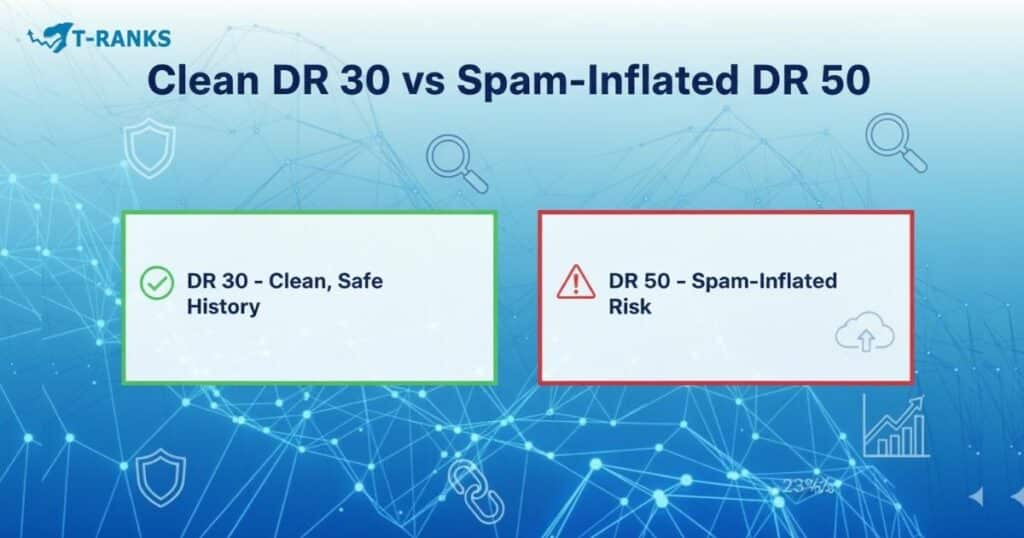
A domain’s past determines its long-term safety. Two sites can share the same DR, but one may be risky if it previously hosted spam content.
Clean domains cost more because they:
- Have natural backlink profiles
- Avoid spammy anchors
- Are less likely to get deindexed
- Pass more reliable authority
Spam-heavy domains are cheaper, but they carry a higher chance of penalty or devaluation.
Key rule:
A clean DR 30 domain is always safer than a spam-inflated DR 50 domain.
3. Content Quality and Relevance
The content surrounding your link affects how natural and trustworthy the link appears. Good vendors invest in niche-relevant, human-edited, or well-checked AI content. This increases their operational cost, which increases link price.
High-quality content matters because:
- Google checks the context around your link
- Relevant articles improve trust signals
- Well-written content reduces footprint risk
- Niche relevance increases ranking impact
Poor-quality content (thin, spun, off-topic) is cheaper but more dangerous.
Simple rule:
A DR 40 link in relevant content is better than a DR 50 link placed inside a weak or generic article.
4. Hosting Diversity and Footprint Safety
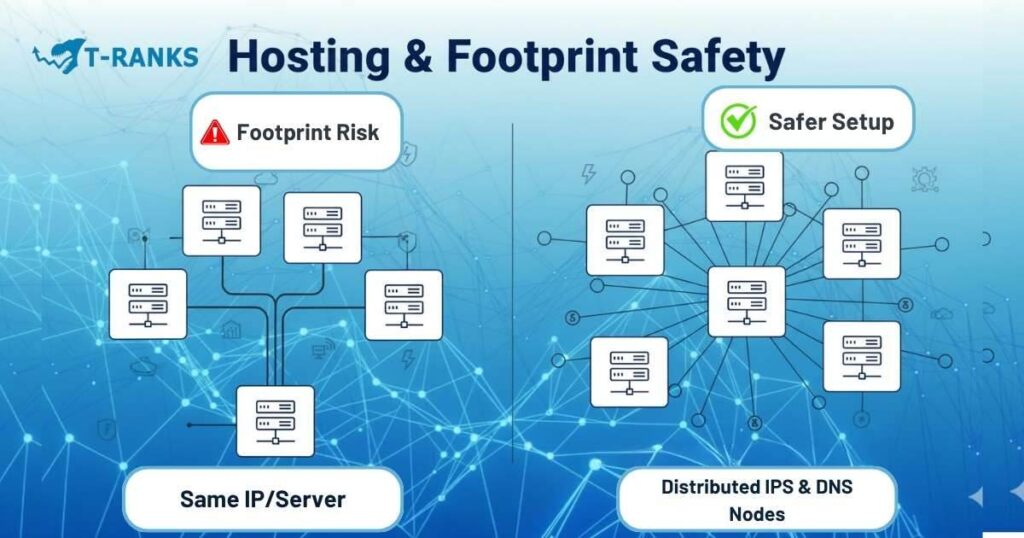
Hosting is one of the clearest ways Google can detect a PBN. Cheap PBNs place many sites on the same:
- IP address
- Server
- Registrar
- DNS
This creates a footprint.
Quality PBNs use unique hosting setups, which cost more but protect the network.
Hosting diversity affects price because:
- Unique IPs cost money
- Different registrars require more management
- Custom hosting setups reduce footprint signals
- Google is less likely to connect the sites
A link from a PBN with proper hosting diversity is always safer and more stable.
5. Link Placement, Anchor Text, and Indexation
Three simple placement factors influence price:
1. Placement
- Contextual, in-content links cost more because they look natural and carry more authority
- Sidebar or footer links cost less and are often discounted by Google
2. Anchor Text
Natural and varied anchors require planning. Keyword-stuffed anchors are risky and cheap.
3. Indexation
If the linking page is not indexed, the link passes zero value.
High-quality PBN vendors ensure pages are indexed or provide replacement links.
Rule:
Pay for contextual + indexed links only.
6. Vendor Pricing Models
Pricing also changes depending on how the vendor sells the link.
Rental Links
- Paid monthly
- Low upfront cost
- High risk because links disappear if payments stop
- Short-term use only
Lifetime Links
- One-time payment
- Permanent and more stable
- Better for long-term SEO
- Higher upfront cost but lower long-term cost
Subscription Bundles
- Mixed links across domains
- Can save money
- Quality varies
- Must check providers carefully
Key rule:
Choose lifetime links for stability. Use rentals only for short experiments.
PBN Link Pricing Tiers and Value Ranges (2026 Guide)
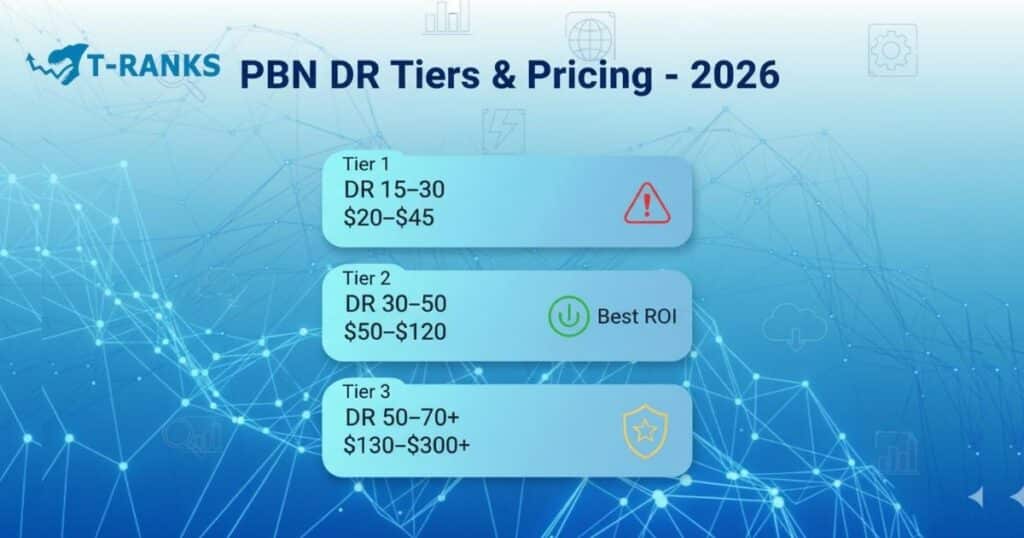
When you start looking for PBN backlinks, you’ll quickly notice one thing:
every provider has different pricing.
This is because PBN links are sold in two major markets, and each market uses its own pricing structure. Understanding these two markets helps you choose the right type of link, compare prices properly, and avoid wasting money.
Category 1: PBN Services from Freelance Platforms
(Fiverr, Legiit, Kwork, SEOClerks, Upwork)
Freelance marketplaces offer the cheapest and widest range of PBN services. Here, you’ll find hundreds of sellers, each with their own:
- Packages (Basic, Standard, Premium)
- Pricing tiers
- Promises (indexing, drip-feed, content, niche edits)
- Reviews and ratings
But these links usually have the same characteristics:
Typical Pricing
- $5 – $40 per link (Basic Tier)
- $40 – $80 for Premium gigs
- Bulk deals like “10 PBN links for $110”
These freelance offers often resemble the risk profile described in T-RANKS’ guide on how to build PBN links that work, where quality control and footprint diversity make a major difference in long-term rankings.
What You Actually Get
- Large public networks
- Generic content
- Mixed niches
- Recycled domains
- Shared hosting footprints
- AI-generated or spun content
- Little-to-no real organic traffic
These are useful only for beginners or for link diversification, not for ranking main money pages.
Why pricing here is cheap
Sellers mass-build networks, reuse domains, and scale volume instead of safety. This is the complete opposite of the controlled setups found in more stable, private networks explained in how to hide PBN links.
Category 2: Professional PBN Providers / Agencies
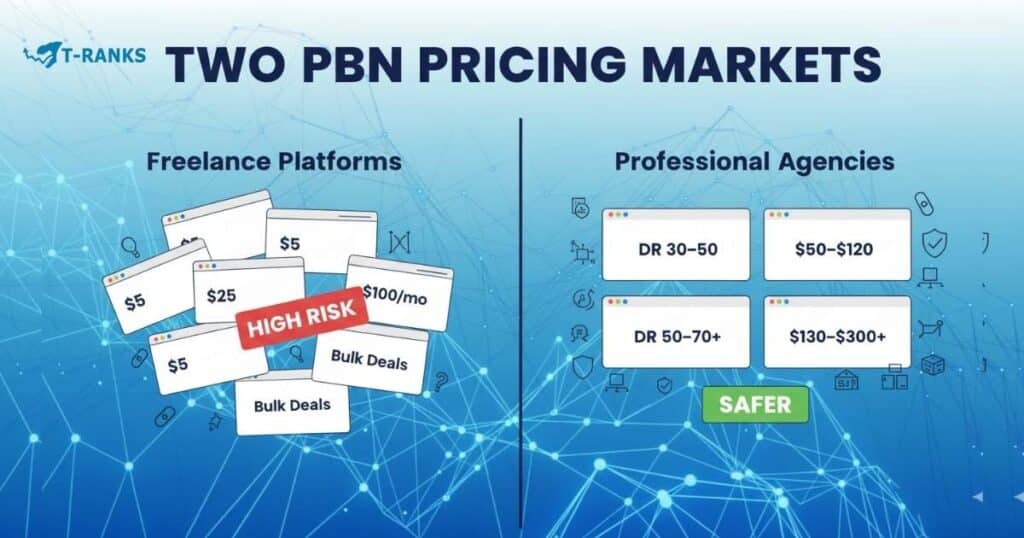
(T-RANKS, PBNLinks.Agency, SirLinksalot, etc.)
Professional agencies charge higher prices because they manage private, controlled networks built for long-term SEO. These networks avoid the common footprints that cause deindexation.
They differ from freelancers in three ways:
- They hand-pick domains (clean backlink history, no spam markers, aged authority).
- They use proper hosting diversity with unique IPs, DNS, and registrar setups.
- They publish niche-relevant content and monitor indexation continuously.
This type of setup follows the same quality principles described in PBN link juice optimization, where content relevance and domain trust significantly increase ranking power.
Typical Pricing
Most agencies use structured pricing based on:
- Niche category (Finance, Tech, Health, etc.)
- Domain DR
- Link placement type
- Rental vs lifetime model
T-RANKS Example
On the Finance niche pricing page you can see:
- Category-based pricing
- DR-based levels
- Link types (homepage, contextual, niche edit)
- Features like unique content and indexing support
This aligns with the overall methodology explained in PBN management tools for maintaining network quality, where each site is treated like an independent authority asset.
SirLinksalot Example
- Monthly homepage rentals
- Niche edit packages
- DR-based contextual links
- Permanent link options
Price ranges:
- $50 – $120 for mid-tier contextual links
- $160 – $400+ for homepage rentals
- $35 – $79 for niche edits
These cost more because they’re built on cleaner, safer networks.
How Agencies Structure Their Pricing (General Model)
Most professional PBN providers (including T-RANKS) follow this structure:
1. Package Type
- Basic (DR 20–30)
- Standard (DR 30–50)
- Premium (DR 50–70+)
2. Link Types
- Homepage link
- Contextual blog link
- Niche edit
- Guest-style links
- Permanent or rental
3. Niche Category
- Finance (highest cost)
- Health (high cost)
- Tech / Business (medium)
- General / Lifestyle (lowest)
These patterns follow the same competitive logic explained in how many PBN links you need to rank, where niche strength and DR level influence both pricing and ranking potential.
The DR-Based Tiers (Across Both Markets)
Below is the complete DR-based value breakdown.
Tier 1: Budget / High-Risk (DR 15–30)
Price Range: $20–$45
Found Mostly On: Freelance platforms
Use For: Link diversity only
Characteristics:
- Generic content
- Weak or recycled domains
- High footprint risk
- Mixed niches
- Limited SEO value
These links often contribute to the weaker areas described in PBN links vs Web 2.0 SEO comparison, where low authority makes ranking inconsistent.
Tier 2: Standard / Balanced (DR 30–50)
Price Range: $50–$120
Found On: Agencies + premium freelance sellers
Use For: Core pages
Characteristics:
- Decent niche relevance
- Clean domain history
- Good hosting diversity
- Reliable indexation
- Strong ranking impact
This category aligns closely with the methods outlined in PBN links vs niche edits, where contextual relevance enhances ranking safety and stability.
Tier 3: Premium / Low-Risk (DR 50–70+)
Price Range: $130–$300+
Found On: Professional PBN agencies only
Use For: Competitive money pages
Characteristics:
- Human-written content
- Full hosting diversity
- Real traffic signals
- Clean long-term backlink history
- Highest stability and safety
These premium placements often match the quality standards highlighted in PBN links vs guest posts, where trust and editorial value matter more than pure DR.
2026 Pricing Snapshot (Final Clean Table)
Tier Type | DR Range | Content Quality | Safety Level | Average Price |
| Freelancer Packages | DR varies | Generic / AI | Low | $5–$80 |
| Tier 1 – Budget | DR 15–30 | Generic | Low | $20–$45 |
| Tier 2 – Standard | DR 30–50 | Niche relevant | Medium | $50–$120 |
| Tier 3 – Premium | DR 50–70+ | High quality | High | $130–$300+ |
Summary
PBN link pricing varies based on the provider and the domain’s quality tier. Freelance platforms offer cheap but high-risk links, while professional PBN agencies provide safer, niche-relevant DR 30–70+ links built on clean, well-maintained aged domains. Prices range from $5 on marketplaces to $300+ for premium, low-risk agency links designed for long-term ranking stability.
How to Evaluate a PBN Link Offer Before Buying (Refined & SEO-Optimized)

Evaluating a PBN link before buying is essential for protecting your rankings and avoiding wasted budget. Even high-DR PBNs can be unsafe if the domain history, content, or placement is poor. This 5-step checklist gives you a simple and reliable way to assess any PBN link offer before investing.
1. Verify DR/TF Metrics (Authority + Trust Check)
Start by confirming the domain’s Domain Rating (DR) via Ahrefs and Trust Flow (TF) via Majestic. These metrics help you evaluate both the strength and trustworthiness of the domain’s backlinks.
- DR measures overall authority, but can be manipulated.
- TF measures the quality of backlinks, which is harder to fake.
- A large gap between TF and Citation Flow (CF) often signals spam.
Example:
- Good: DR 42 / TF 28 → natural, trustworthy profile
- Risky: DR 42 / TF 5 → inflated DR, usually built with low-quality links
- Tip: Always verify metrics yourself. Never rely on screenshots from sellers.
2. Check Domain History (Past Use = Future Risk)
A domain’s history reveals whether it is safe or potentially harmful. Use Wayback Machine and backlink analysis tools to uncover how the site was used previously.
Avoid domains that show:
- past use in adult, casino, pharma, betting, or hacked niches
- frequent niche flips, identity resets, or unnatural rebuilds
- signs of previous manual penalties or doorway pages
Example:
- Safe: A tech blog with consistent content since 2016
- Unsafe: A domain that used to be a casino site, then a “make money fast” blog, then a coupon site
A clean history is *non-negotiable* for PBN safety.
3. Analyze Content Quality (Relevance + Originality)
The quality of content on the PBN site directly affects link strength and detectability.
Look for:
- Original content, not spun or duplicated
- Niche relevance, so your link appears natural
- Readable, human-edited text rather than sloppy AI output
Poor content is one of the biggest footprints Google uses to detect low-quality PBNs.
Example:
- Good: A fitness link placed in an article about “Benefits of Strength Training”
- Bad: The same link shoved into a generic AI article about “Healthy Living and Business Tips”
Quality content = safer, stronger link value.
4. Confirm Link Placement (Contextual + Indexed)
Placement determines the SEO impact of your PBN link.
The highest-value links are contextual, in-body links placed naturally within an article.
Avoid:
- sidebar or footer links
- author-box links
- outdated or irrelevant posts
- links on pages that are not indexed
Example:
- High value: A contextual link placed mid-paragraph in a new, relevant article
- Low value: A footer link appearing on every page of the site
5. Review Spam Score (Risk Indicator)
Use Moz Spam Score or SEMrush Toxicity to identify risky backlink patterns.
A high score indicates potential penalties or a weak backlink environment.
- Under 3%= Safe
- 10–30% = Review carefully
- Over 30% = Avoid
Example:
- Safe: DR 30 domain with Spam Score 2%
- Unsafe: DR 70 domain with Spam Score 35% (high authority but extremely risky)
A high DR never compensates for a high spam score.
Are Expensive PBN Links Always Better?
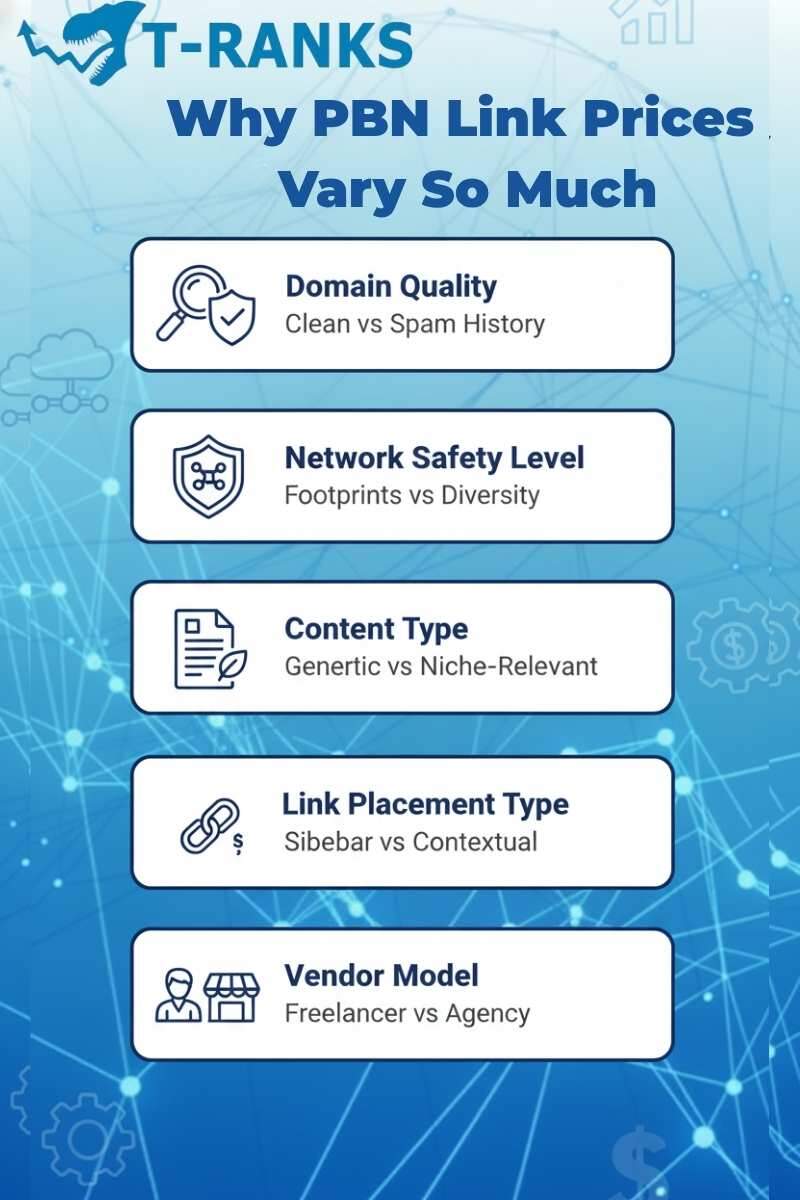
Expensive PBN links often look more powerful because they usually come from higher DR domains, but a high price does not automatically mean better SEO results. What matters most is how natural, relevant, and trustworthy the linking domain appears to Google. A well-curated mid-tier PBN link can outperform a high-DR, high-priced link if it offers stronger contextual alignment and cleaner trust signals.
Why Expensive Links Can Fail
Many high-priced PBN links underperform because the value is based on metrics, not quality. Common reasons include:
- High DR inflated by outdated or irrelevant backlinks
- Weak Trust Flow despite strong DR
- Thin, low-quality, or generic content
- Niche mismatches created by domain history changes
- Hosting footprints that signal an unsafe PBN
- Zero real organic traffic or user engagement
- Overused domains selling links in bulk
These weaknesses mean that even a DR 70+ expensive link can fail to pass meaningful ranking power.
Why Mid-Tier Links Often Deliver Better ROI

The strongest PBN results usually come from DR 40–55 domains because:
- Their backlink profiles are cleaner and more consistent
- They have tighter niche relevance
- Their content is fresher and more natural
- They carry fewer footprints
- Their prices are reasonable, allowing multiple placements
- Their ranking effects accumulate faster with less risk
This range provides the best balance between price, trust, and long-term impact.
One Strong Real-World Example
A marketer paid $180 for a DR 72 PBN link expecting strong results. The domain had high DR but thin content and weak Trust Flow, so the page showed no ranking movement.
Later, they invested in two DR 48, niche-relevant PBN links for $70 each. Both domains had clean histories and strong contextual alignment.
These mid-tier links moved their keyword from #18 to #11 because they were safer, more relevant, and carried higher actual trust.
This example proves that price and DR alone cannot determine link value.
How to Evaluate Any PBN Link Before Buying
(Evidence-Based Buying Checklist)
Before purchasing any PBN link—cheap or premium—verify:
Domain Quality
- Clean backlink history
- No spam anchors
- No toxic referring domains
- No history of penalties
Relevance & Content
- Niche matches your topic
- Human-edited or well-structured AI content
- Consistent publishing pattern
Technical Signals
- Indexation status
- Unique hosting (IP, DNS, registrar)
- SSL and proper site setup
Performance Indicators
- Real organic traffic
- Clean anchor text distribution
- Healthy Trust Flow vs Citation Flow
If a link does not pass these checks, its price—high or low—is irrelevant.
Key Takeaway
Expensive PBN links are not automatically better.
Links with clean history, strong contextual relevance, natural content, and safe hosting consistently outperform high-priced DR-inflated placements.
The best ROI usually comes from mid-tier, niche-relevant PBN sites that maintain trust and avoid footprints—regardless of the price tag.
Future Trends in PBN Link Pricing (2026–2027)

PBN link pricing is changing fast. Google is putting more value on trust, relevance, and how “real” a site looks. This means PBN prices in 2026–2027 will depend less on DR numbers and more on safety, domain history, content quality, and how well a network hides footprints. Below are the main trends buyers should expect.
Aged, Clean Domains Will Become More Expensive
Strong, clean expired domains are getting harder to find. The domains that rank best in PBNs today are the ones that:
- stayed in one niche for many years
- have no spam history
- have natural backlinks and brand-style anchors
These domains are rare. As more buyers compete for them, prices will rise. Networks built on 8–10+ year-old domains will move into the Authority or Premium pricing range.
In 2027, DR alone will not decide price. What matters most will be domain stability and niche consistency.
AI Content Will Create Two Pricing Layers
AI has made it cheaper to create large amounts of basic PBN content. This will keep Starter-tier links low-cost because cheap networks rely on fast, automated posting.
But Google is getting better at spotting low-quality AI articles. So higher-tier networks will shift toward:
- human-edited AI drafts
- fact-checked content
- niche-relevant articles that show some E-E-A-T
This type of content is more expensive to produce, so Premium-tier links will continue to increase in price.
Low-effort AI networks will struggle to raise prices because their articles will not survive long-term quality checks.
Brand-Style PBNs Will Become the Premium Standard
The strongest PBNs in 2026–2027 will look like real brands. These networks will have:
- proper designs and layouts
- author pages
- small but real social signals
- consistent publishing
- some organic traffic
Because they look natural, Google has a harder time flagging them as PBNs.
However, building this type of network requires more investment, so these links will become the highest-priced tier in the market.
Infrastructure and Indexation Costs Will Slowly Push Prices Up
Behind every safe PBN is a long list of technical expenses:
- hosting on unique IPs
- proxies and DNS diversity
- indexation tools
- uptime monitoring
All of these costs are rising each year. Indexing is also becoming harder, so agencies must invest more in tools and systems.
These expenses affect mid-tier and premium PBN prices the most, as those networks depend on strong stability and consistent indexation.
Transparency Will Decide Which Networks Win
Google’s link spam detection continues to improve. Buyers will become more careful and will want proof before paying high prices.
Networks that can show:
- clean history
- low spam indicators
- real screenshots
- indexation proof
- hosting and IP diversity
will attract more buyers and command higher prices.
Networks that hide everything, rely on inflated DR, or use weak hosting footprints will lose trust even if their metrics look good.
Example: What This Future Looks Like
In 2027, a buyer may compare:
- $90 link from a DR 55 site with generic AI content and no traffic
- $170 link from a DR 48 branded, niche-stable site with clean history and real content
Most experienced SEOs will choose the second option because Google is rewarding trust, history, and natural behavior, not big DR numbers.
How Buyers Should Prepare for 2026–2027
Smart buyers will adjust by:
- choosing aged and niche-stable domains
- avoiding fully automated AI PBNs
- investing more in brand-like networks
- asking for transparency before buying
- valuing trust and clean history over high DR
- understanding that safe networks cost more to operate
In this new environment, the PBN links that will rise in price and deliver the strongest results are the ones that look real, behave naturally, and show long-term stability. DR alone will not be enough to judge value.
Conclusion: Using PBNs Safely and Cost-Effectively in 2026 and Beyond
In conclusion, using PBNs in 2026 requires a clear focus on safety, relevance, and real value rather than chasing the biggest metrics or the lowest prices. The strongest results come from links placed on clean, niche-consistent domains with natural content, stable history, and reliable indexation. Expensive links are not always better, but evidence-based evaluation always is.
Choosing PBNs that match your niche, show transparent data, and follow strong hosting and content practices will protect your rankings and improve long-term ROI. The key is simple: invest in networks that behave like real websites and avoid anything that looks automated, spam-heavy, or poorly maintained.
If you want safe, high-quality PBN links built on aged domains with real topical alignment, get in touch with T-RANKS for a transparent, trusted, and results-driven PBN strategy.
If you want safe, high-quality PBN links built on aged domains with real topical alignment, get in touch with T-RANKS for a transparent, trusted, and results-driven PBN strategy.
Contact T-RANKS NowFAQS
1. What is PBN link pricing?
PBN link pricing is the amount you pay for a backlink placed on a private blog network site. The cost depends on the domain’s authority, niche relevance, content quality, and how safe the network is to use.
2. How much do PBN links cost in 2026?
Most PBN links cost between $25 and $150. Budget links sit around $25–$40, while aged, clean, niche-relevant domains with safer setups usually cost $100 or more.
3. Why do PBN link prices vary so much?
Prices differ because every PBN has different strengths. Clean history, good metrics, quality content, and solid hosting diversity make a link more expensive. Cheap networks usually skip these steps, which lowers their price and safety.
4. Are expensive PBN links always better?
No. High price doesn’t always mean high value. A mid-tier link from a clean, niche-matched domain can outperform a costly high-DR link with weak trust signals or a risky footprint.
5. What factors affect PBN link pricing the most?
The biggest pricing factors are domain metrics (DR/TF), backlink history, content quality, link placement, and how well the network hides its footprints.
6. How do I know if a PBN link is worth the price?
A link is worth buying if the domain has a clean backlink history, low spam indicators, niche-relevant content, and strong indexation. Checking these elements ensures real ranking value.
7. Are PBN link rentals worth it?
Rentals work only for short campaigns. They are cheaper at the start, but the link disappears when payments stop. Permanent links are better for stable, long-term authority.
8. What is the difference between DR and TF in pricing?
DR shows the overall strength of a domain’s backlinks. TF shows how trustworthy those backlinks are. High-TF domains usually cost more because trusted links are harder to find and safer to use.
9. Can Google detect PBN links in 2026?
Yes. Google can still detect poorly built PBNs. Networks with shared footprints, thin content, or repeated anchors are high-risk. Networks with diverse hosting and natural content are harder to detect.
10. How can I compare PBN prices across vendors?
Compare vendors by checking five things together: DR, TF, domain history, content quality, and link placement. A simple spreadsheet helps you see which option gives the best value.
11. What happens if a PBN link gets deindexed?
If a PBN link is deindexed, it stops passing SEO value immediately. Replace it quickly or request a new placement to avoid weakening your rankings.
12. How do I calculate ROI from PBN links?
Track ranking changes, traffic growth, and conversions after placing the link. Compare those gains with the total cost of the link to see whether it delivered profit or loss.

